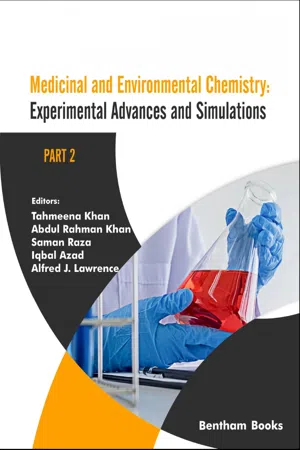
Medicinal and Environmental Chemistry: Experimental Advances and Simulations (Part II)
- English
- ePUB (mobile friendly)
- Available on iOS & Android
Medicinal and Environmental Chemistry: Experimental Advances and Simulations (Part II)
About this book
Medicinal and Environmental Chemistry: Experimental Advances and Simulations is a collection of topics that highlight the use of pharmaceutical chemistry to assess the environment or make drug design and chemical testing more environment friendly. The eleven chapters included in the second part of this book set cover diverse topics, blending the fields of environmental chemistry and medicinal chemistry and have been authored by experts, scientists and academicians from renowned institutions. This part is more specialized in nature, focusing primarily on the effects of air pollution and water contamination on human health. Chapters covering pharmaceutical interventions and pollution control measures, respectively follow these initial topics. Part II also features specialized topics that aim to address some unique challenges of the above mentioned problems including antibiotic pollution, pharmaceutical analysis of pollutants, chemosensors, biosteric modifications and new drug development strategies against SARS-CoV2. Key Features: 1. 11 topics which blend environmental chemistry and medicinal chemistry2. Contributions from more than 40 experts3. Includes topics covering effects of air pollution on human health and disease4. Includes specialized topics on pharmaceutical analysis in the environment, and modifications of compounds for pharmaceutical purposes5. Bibliographic references This reference is an essential source of information for readers and scholars involved in environmental chemistry, pollution management and pharmaceutical chemistry courses at graduate and undergraduate levels. Professionals and students involved in occupational medicine will also benefit from the wide range of topics covered.
Frequently asked questions
- Essential is ideal for learners and professionals who enjoy exploring a wide range of subjects. Access the Essential Library with 800,000+ trusted titles and best-sellers across business, personal growth, and the humanities. Includes unlimited reading time and Standard Read Aloud voice.
- Complete: Perfect for advanced learners and researchers needing full, unrestricted access. Unlock 1.4M+ books across hundreds of subjects, including academic and specialized titles. The Complete Plan also includes advanced features like Premium Read Aloud and Research Assistant.
Please note we cannot support devices running on iOS 13 and Android 7 or earlier. Learn more about using the app.
Information
Novel Drug Development Strategies- A Case Study With SARS-CoV-2
Iqbal Azad1, *, Tahmeena Khan1, Mohammad Irfan Azad2, Abdul Rahman Khan1
Abstract
* Corresponding author Iqbal Azad: Integral University, Lucknow, India; E-mail: [email protected]
INTRODUCTION
Factors affecting the spread of SARS-CoV-2
Environmental Factors
| S. No. | Country | Confirmed Cases | Recovered Cases | Deaths |
|---|---|---|---|---|
| 1 | United States | 33,66,515 | 9,88,656 | 5,71,444 |
| 2 | Brazil | 18,66,176 | 12,13,512 | 1,37,191 |
| 3 | India | 8,78,254 | 5,53,470 | 72,151 |
| 4 | Russia | 7,33,699 | 5,04,021 | 23,174 |
| 5 | Peru | 3,26,326 | 2,42,474 | 11,439 |
| 6 | Chile | 3,15,041 | 2,83,902 | 11,870 |
| 7 | Mexico | 2,99,750 | 1,84,764 | 6,979 |
| 8 | United Kingdom | 2,90,133 | No data | 35,006 |
| 9 | South Africa | 2,76,242 | 1,34,874 | 44,830 |
| 10 | Iran | 2,59,652 | No data | 4,079 |
| 11 | Worldwide | 1,29,45,505 | 70,01,675 | 5... |
Table of contents
- Welcome
- Table of Content
- Title
- BENTHAM SCIENCE PUBLISHERS LTD.
- FOREWORD
- PREFACE
- List of Contributors
- Air Pollution and its Impact on Respiratory Health
- Cytochrome P450 and Health Hazards of Smog
- Pharmaceutical and Modelling Interventions for Environmental Pollution Related Chronic Obstructive Pulmonary Disease
- Arsenic Toxicity of Groundwater and Its Remediation for Drinking Water
- Studies on Polymeric Ceramic Composite Membranes for Water Treatment
- Chemosensors For Anions Of Biological and Environmental Relevance
- Antibiotic Pollution: Challenges and Strategies
- Analytical Advancement for Pharmaceuticals Quantification in Environmental Matrices
- Use of Bioisosteric Functional Group Replacements or Modifications for Improved Environmental Health
- Gold and Silver Nanoparticle Synthesis by Pyrus and Eurya: Environment-Friendly Therapeutic Agents
- Novel Drug Development Strategies- A Case Study With SARS-CoV-2